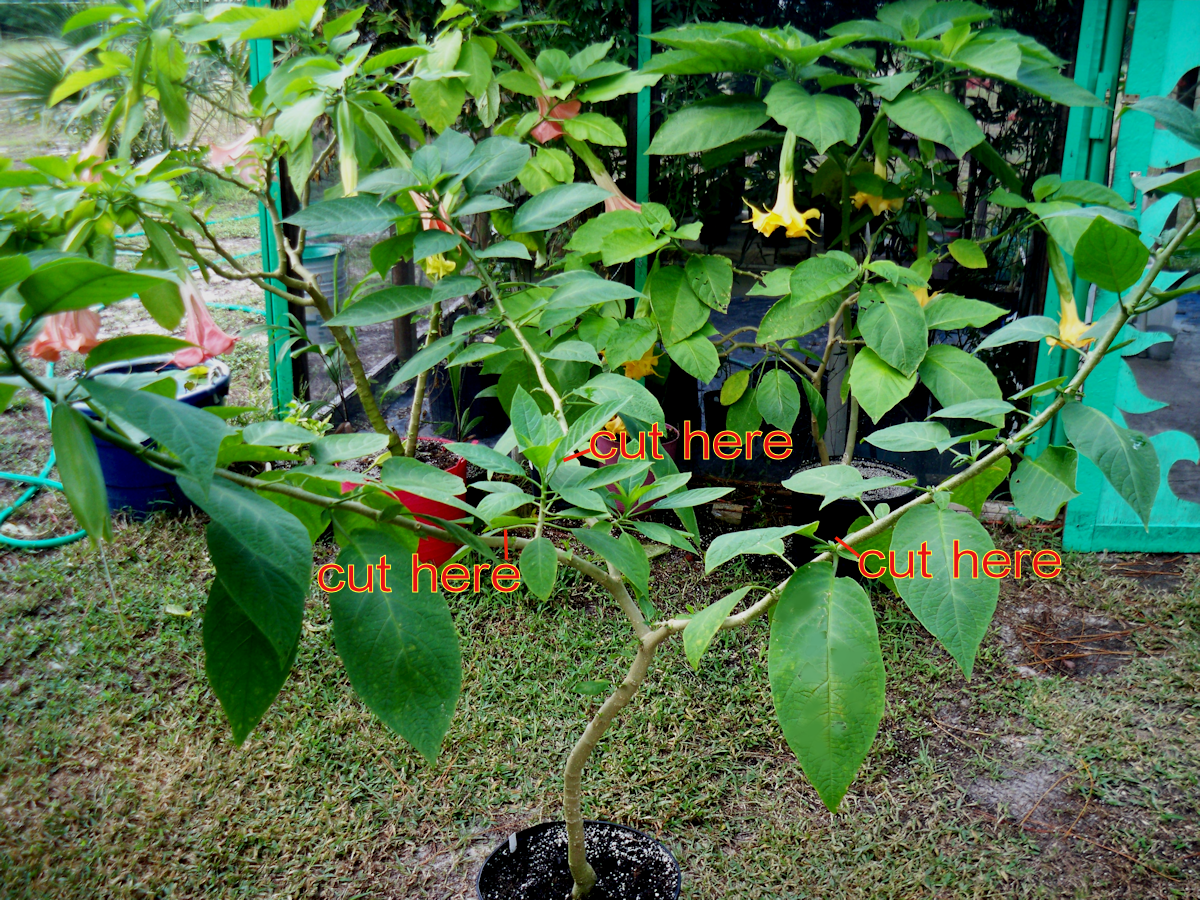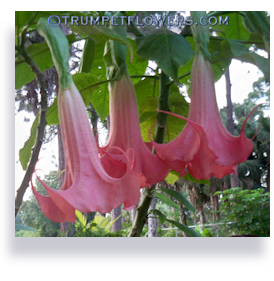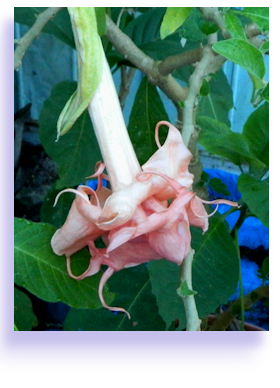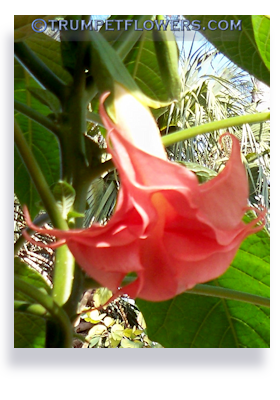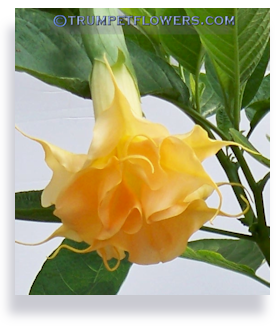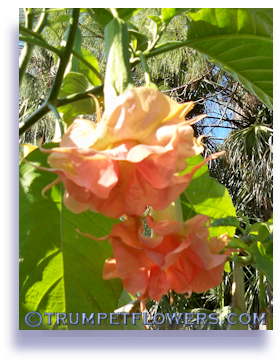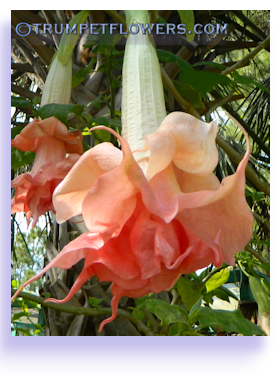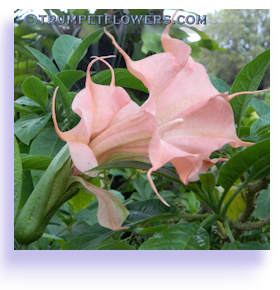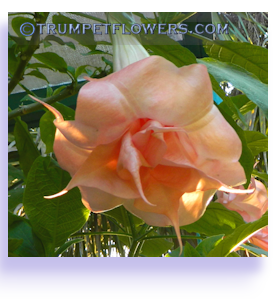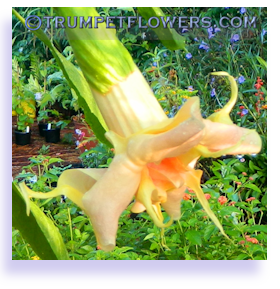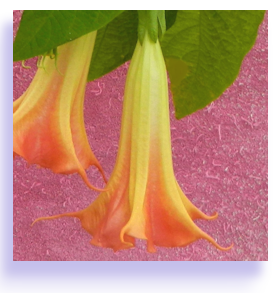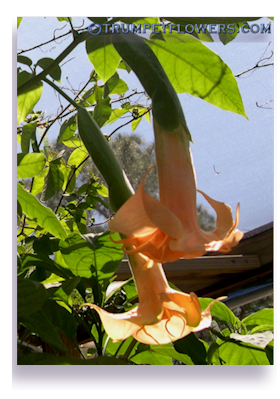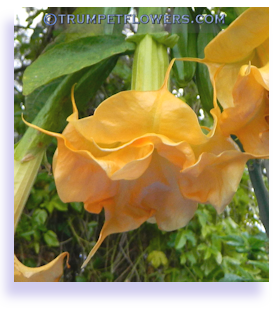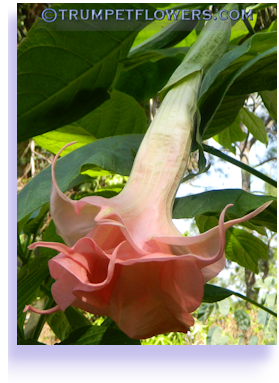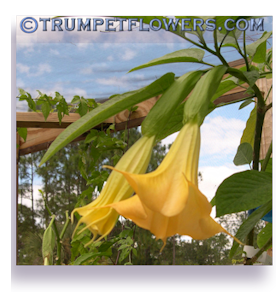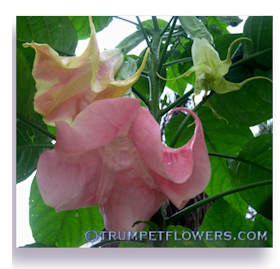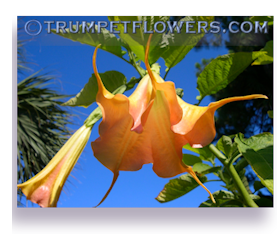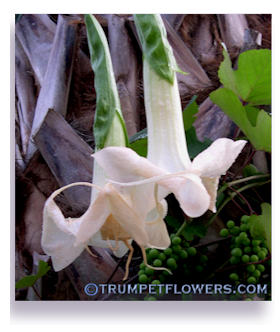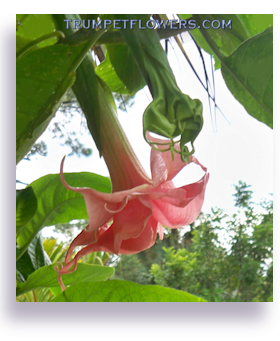Pruning Brugmansia
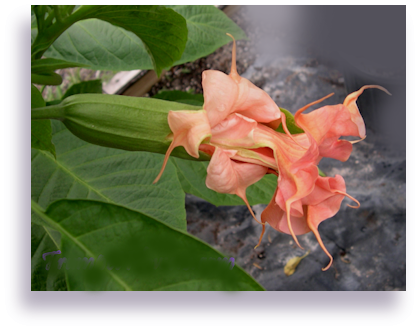 Pruning a Brugmansia, or Angel Trumpet, is just a bit of a tricky procedure. First, let's understand a few things about the plant's natural growing habits.
Pruning a Brugmansia, or Angel Trumpet, is just a bit of a tricky procedure. First, let's understand a few things about the plant's natural growing habits.
When Brugmansia is found in her natural environment, it is often found as an understorey small tree or shrub, with branches going every∼whicha∼ways, tightly wound and with no apparent shape. When the plant is cultivated, this changes the entire appearance, giving it the elegance and grace so deserving of the breathtaking blooms the plant puts forth.
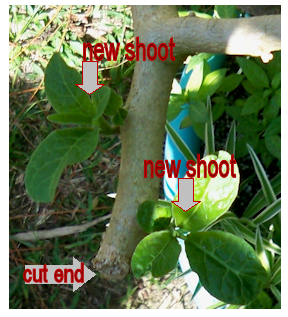 Brugmansia, like some other noteable plants, needs to first create a Y shape in the original trunk before it will set blooms.
(Click Here for photographic example on another page)
To cut below this point on the trunk would only encourage more vegetative growth along the trunk. This means the trunk itself will leaf out along each node point. It will also grow a new main trunk in most cases, making the plant appear lopsided. Plus, no blooms. Not a good idea to cut below the fork.
Brugmansia, like some other noteable plants, needs to first create a Y shape in the original trunk before it will set blooms.
(Click Here for photographic example on another page)
To cut below this point on the trunk would only encourage more vegetative growth along the trunk. This means the trunk itself will leaf out along each node point. It will also grow a new main trunk in most cases, making the plant appear lopsided. Plus, no blooms. Not a good idea to cut below the fork.
Going from the Y upwards, the plant will now begin to form a branch on each branch of the original Y. And so on and so on. This is how the tree naturally shapes. The problem is, (or not, see last example on how to prune) that it can sprout side shoots straight up out of the ground, and also sideshoots from other various areas on the trunk and branches, that give it a misshapen look. These are the branches that you will be removing to give the tree back a good form.
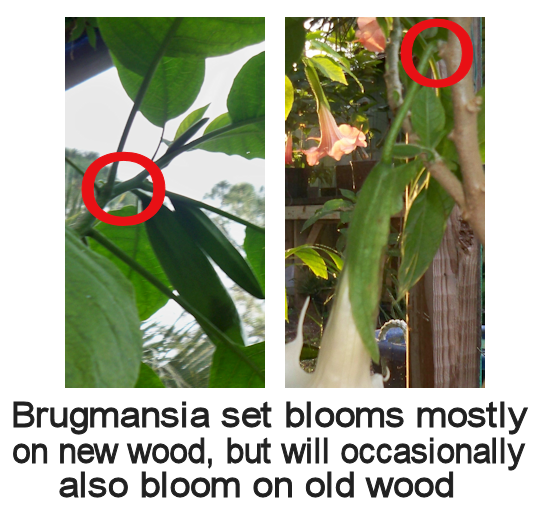
The name Standard is given to a brugmansia plant that is shaped into a tree form. This is the most common shape chosen, and used by most all hybridizers. The other shape is Bush, and the plant is basically allowed to keep all of it's sideshoots and ground shoots. This form will give a tighter, shrubbier looking plant, and you will get less view of the flowers when they occur. Brugmansia are hardly ever used as privacy hedges, but if you want the bush shape, you really do not have to do anything to the plant. If it gets too leggy, you would have to prune harshly, to get the plant growing green wood deep in by the trunk. Remember, green wood is flowering wood.
 Something to note here gardeners, is the habit of the mother brugmansia plant and the shoot. If you cut the shoot off as I mentioned, the mother plant remaining will grow another. But if you pull the shoot out completely, roots and all, the mother plant will never regrow another shoot. Keep this in mind when removing the shoot. Many people want their brugmansia to continue making shoots, for purpose of propagation or just to replace an old mother plant. If you do pot up the new shoot, roots and all, it will make shoots of it's own in the future.
Something to note here gardeners, is the habit of the mother brugmansia plant and the shoot. If you cut the shoot off as I mentioned, the mother plant remaining will grow another. But if you pull the shoot out completely, roots and all, the mother plant will never regrow another shoot. Keep this in mind when removing the shoot. Many people want their brugmansia to continue making shoots, for purpose of propagation or just to replace an old mother plant. If you do pot up the new shoot, roots and all, it will make shoots of it's own in the future.
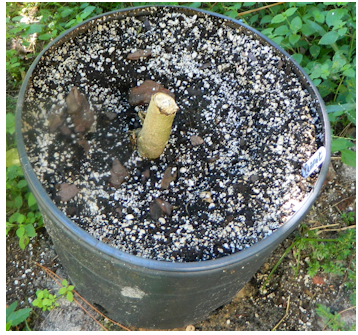 You can also prune a brugmansia all the way down to the vegetative growth stage on the trunk. Some people do this is if they want to bring the mother plant indoors in winter, but do not have a lot of room for all the branching out. Cutting the plant down this low on the trunk will result in multiple growing shoots along the main trunk, which will create a bushy shape. It may even spring up shoots from the underground, as shown by two of the arrows in the next picture.
You can also prune a brugmansia all the way down to the vegetative growth stage on the trunk. Some people do this is if they want to bring the mother plant indoors in winter, but do not have a lot of room for all the branching out. Cutting the plant down this low on the trunk will result in multiple growing shoots along the main trunk, which will create a bushy shape. It may even spring up shoots from the underground, as shown by two of the arrows in the next picture.
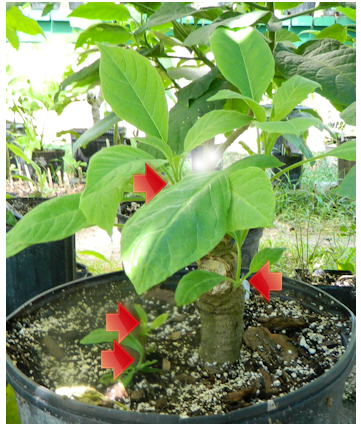 This is advantageous for those of you who want a bush shape, or those of you who want more plant material, or, as previously mentioned, just need more space come wintertime.
This is advantageous for those of you who want a bush shape, or those of you who want more plant material, or, as previously mentioned, just need more space come wintertime.
 If you live in a climate with a short growing season, it is best to not trim the plant below the first Y. This way the plant will mature enough when it wakes up in spring to go ahead and put out flowers that same year.
If you live in a climate with a short growing season, it is best to not trim the plant below the first Y. This way the plant will mature enough when it wakes up in spring to go ahead and put out flowers that same year.
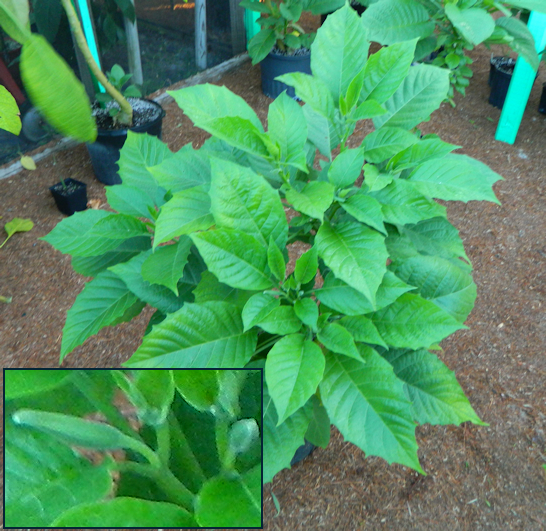
The brugmansia pictured above is the same one as in the two photos above that, cultivar Rosalla, 3 months later. It has already completely filled in after the sharp pruning and has tons of calyxes/blooms on it. Rosalla sets blooms faster after cutting than any brugmansia I have ever experienced. If you live in an area with a short growing season, or just want flowers NOW, I highly suggest you have Rosalla in your collection. Rosalla can also throw a double bloom your way now and again, only matched by Joli.
To start a brugmansia off to the standard shape, there are two ways to go about this. One method involves removing any groundshoots that have shot up from the ground surface. Cut them below the surface of the soil, and while the cut is still exposed, seal it with warmed wax or a pruning seal product.
Next, remove any leaf growth that is on the trunk of the tree, up to the first Y.
After the Y, cut the main branches from the forks back into older wood, as shown in photo. Make sure to do this above a node (perhaps choosing one where another branch is beginning to fork) and cleanly across. Seal the wound with warm unscented candle wax, latex paint, or pruning sealer. You can keep the remaining branch parts for stem cuttings. Also, if there are any dead or dying branches above the Y, cut these off now, back to the main live stem or the trunk.
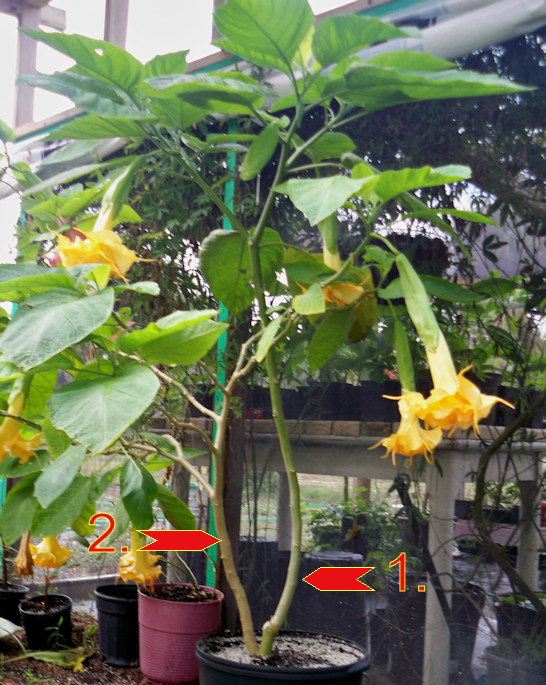
Another technique is to keep the large shoot (pictured above as number 1) that almost always appears from the soil, next to the main, older trunk. This new shoot will be strong, grow quickly, and is almost always straighter than the original. Stake the shoot to straighten it even more, and in a couple of months it will harden enough to remove the stake. Green wood on brugmansia has a lot of give, so do not be shy about pulling it in and staking it.
So again, cutting off number two at the base, and allowing the newer, greener trunk to become the new standard brugmansia, is advantageous. Save of course, the number 2 trunk for new cuttings. And one more point to make about this. Look up into the forming canopy of number 1 trunk. Notice a much neater shape and overall appearance to it? This is going to be a better looking adult brugmansia. More green wood, more flowers too.Here's the same Langenbusher Garten (yellow brugmansia in photo) after cutting mother off. Look at these blooms now!
Take note that this page was written up August 22nd, 2012. I caught the Langenbuscher Garten blooms (no. 1 in above photo) on March 31st, 2013. So that is about 7 months of winter wait for the blooms he has on him now. Not bad! He is now about 6 feet tall.
I swear by the velcro lengths you can find at Home Depot and Lowes for strapping them. It is soft on one side, can be cut to any length you want, and lasts for about 3 years before it becomes brittle from constant exposure to the climate. It is also affordable. Find it in the garden section, boxed. You can see one of the ways I use it here. I often double and triple wrap the trunks of young saplings I've placed in the ground with the velcro straps, around the trunk and a sturdy stake. Even our tropical storms don't snap it, and the trees grow nice and straight. The velcro strapping is soft, and wide enough it does not do any damage to the trunk, unlike rope.

Tags: pruning a brugmansia, prune angel trumpet, angel trumpet pruning procedure, pruning angel trumpets, brugmansia pruning, prune brugmansia, y shapes in angels trumpets, standard tree form,
This entry was posted on August 22nd, 2012 and is filed under Brugmansia Information.
